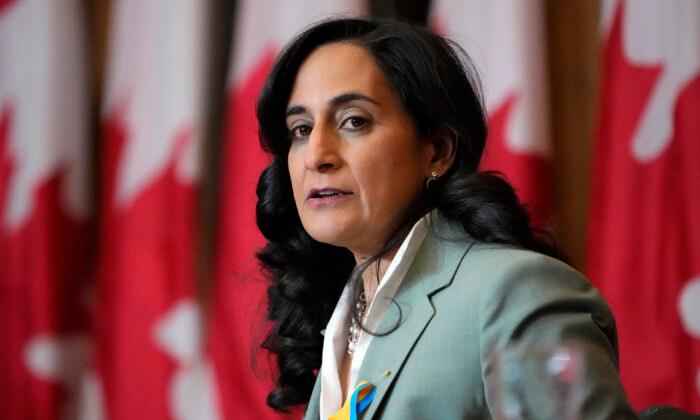The Canadian government intends to significantly increase defence spending; however, recent history has shown the feds have struggled to meet capital expenditure targets.
With a renewed focus on defence spending in light of Russia’s invasion of Ukraine, Defence Minister Anita Anand, speaking at the Ottawa Conference on Security and Defence on March 11, promised a “robust package to modernize NORAD [North American Aerospace Defence Command].”
“Despite the global pandemic, we are still on track to increase our defence spending from $18.9 billion to $32.7 billion dollars in 2026–27,” Anand added.
But Parliamentary Budget Officer (PBO) Yves Giroux told The Epoch Times, “It doesn’t look like it’s going to be an easy task to achieve—that big an increase in procurement for DND [Department of National Defence] expenditures.”
The PBO said, in a March 11 report analyzing capital spending under the 2017 national defence policy Strong, Secure, Engaged (SSE), that the DND was regularly underspending compared to projections.
The cumulative shortfall was almost $10 billion, from fiscal 2017–18 to 2020–21, for what DND was supposed to have spent according to SSE.
And now, the new spending profile shows higher capital spending starting in 2025–26 until the end of SSE’s 20-year horizon, in 2036–37—spending from the first four years of SSE has been shifted into the future.
“The substantial acceleration in capital spending from 2023–24 to 2027–28 potentially raises questions regarding the ability of the government to manage increased procurement activity,” said the PBO report, which notes that the planned spending in 2027–28 is at least three times higher than capital spending was in any prior fiscal year over the past 20 years.
Anand’s NORAD modernization package would be in addition to projected spending under SSE, since the originally announced policy funding didn’t include those costs or major future operations. A major component of NORAD modernization would include working with the United States to upgrade the North Warning System—a network of radar across the Canadian Arctic built in the 1980s.
Aside from procurement, other reasons Giroux provided that would create difficulties for the feds to meet defence spending goals include inflation and competition for supply, as many other nations are also increasing their defence spending.
“That could in turn put strains on suppliers of that equipment, including domestic suppliers. Even if the acquisition of material is not done exclusively domestically, that could put significant strains in Canada.”
And regarding achieving the target defence spending of 2 percent of gross domestic product (GDP), which all NATO members agreed to in 2014, Giroux also noted the headwind caused by rapidly rising prices.
With annual inflation now at 5.7 percent, the PBO said higher appropriations may be needed to cover spending that was supposed to have already taken place.
“When you have inflation running at a higher rate than what you expect, meeting the 2 percent target of defence spending in relation to GDP will require a bigger effort on the part of the government,” Giroux said. “You have to spend proportionately more to ensure that you meet the 2 percent target.”
As it stands now, Canada is spending an estimated 1.39 percent of GDP on defence, according to the CIA’s country comparison of military expenditures.
Tradeoffs
With an upcoming budget, defence spending now appears to be a higher priority than it has been in some time.
Richard Fadden, former deputy minister of defence and national security adviser to Prime Minister Stephen Harper, told defence conference attendees on March 11 that an increase in defence spending “will apply a great deal more pressure on the debt and the deficit, which means that the government’s social and economic agenda is going to have to suffer or the debt and the deficit is going to increase noticeably.”
“If you’re talking about increasing the defence budget, we’re not talking about $100 million. That’s just change. We’re talking about billions,” he said.
The PBO pointed out in its economic and fiscal outlook report, released March 1, that the government still has $48.5 billion in new spending to fulfill as remaining electoral platform measures.
Giroux also noted that with the provinces demanding more funding for health-care spending, and with the additional demands for defence spending, there would be significant pressure on the deficit if the feds moved on all three fronts at the same time.
“But the key question is whether the government will want to move on all three fronts,” he said.
Test for Procurement, Tracking Accountability
Defence procurement has long been a stumbling block for the government, with the purchase of fighter jets being a case in point. Anand said the government is moving forward this year to award a contract for 88 new fighter jets.
Retired Lieutenant-General Christine Whitecross, who moderated the discussion with Anand, called the procurement system “rigid and slow.”
The defence minister—and one-time procurement minister—pushed back.
“When procurement wants to act, procurement can act,” Anand said, pointing to the procurement of COVID-19 vaccines, in which she said Canada led the world.
“We have the expertise at the table and we are going to see more modernization of procurement processes.”
But the real test for Canada’s procurement system is coming in the next few years as defence spending is projected to significantly ramp up, Giroux said.
“As to whether there have been improvements in the procurement process, I think it’s a bit too early to tell, still.”
Historically there have been difficulties in tracking, reconciling, and demonstrating accountability for government spending for large capital-intensive projects with lifetimes spanning multiple years.
Giroux said it has proved challenging for the government to have one central repository to keep track of spending, but he sees signs of improvement.
“Things have improved significantly over time. I think it’s by us asking these questions. So I think it forces government departments to be much closer, much, much better at scrutinizing, or keeping track of their own expenditures.”
The PBO can say it has now fully reconciled the $164 billion spent on capital acquisitions under SSE thus far.





